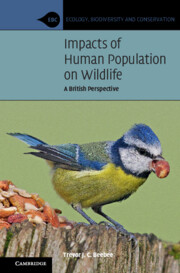Book contents
- Impacts of Human Population on Wildlife
- Ecology, Biodiversity and Conservation
- Impacts of Human Population on Wildlife
- Copyright page
- Dedication
- Contents
- Preface
- Acknowledgements
- Abbreviations
- 1 Population Matters
- 2 The State of British Wildlife
- 3 Human Activities Directly Killing Wildlife
- 4 Impacts of Development on Wildlife Declines
- 5 Impacts of Farming and Forestry on Wildlife Declines
- 6 Climate Change, Disease and Disturbance
- 7 The Human Population and Wildlife in Britain and Western Europe
- 8 Public Perceptions of Wildlife and Population Issues
- 9 International Aspects of Population Growth
- 10 Conservation in a Crowded Country
- References
- Index
3 - Human Activities Directly Killing Wildlife
Published online by Cambridge University Press: 09 June 2022
- Impacts of Human Population on Wildlife
- Ecology, Biodiversity and Conservation
- Impacts of Human Population on Wildlife
- Copyright page
- Dedication
- Contents
- Preface
- Acknowledgements
- Abbreviations
- 1 Population Matters
- 2 The State of British Wildlife
- 3 Human Activities Directly Killing Wildlife
- 4 Impacts of Development on Wildlife Declines
- 5 Impacts of Farming and Forestry on Wildlife Declines
- 6 Climate Change, Disease and Disturbance
- 7 The Human Population and Wildlife in Britain and Western Europe
- 8 Public Perceptions of Wildlife and Population Issues
- 9 International Aspects of Population Growth
- 10 Conservation in a Crowded Country
- References
- Index
Summary
Humans have a long history of destroying wildlife in a variety of ways. Initially, this was mostly manifest as hunting for food and removal of competing predators. Some species were exterminated by these activities. Later came collection, especially of rare species, for museums and private collections. Plants and bird eggs were especially vulnerable, as were attractive invertebrates such as butterflies. Despite protective legislation, collection continues around the world, and the wildlife trade is thriving. Persecution of ‘pest’ species also continues apace, where the definition of pest is highly contentious. Badgers are killed regularly, as are animals likely to predate game on shooting estates. Predation of wildlife for human consumption is in most cases now only carried out on a small scale, but marine fish are an exception. They continue to be harvested around UK shores, and elsewhere, in unsustainable numbers. Pressure on fish stocks is exacerbated by increasing numbers of human consumers.
- Type
- Chapter
- Information
- Impacts of Human Population on WildlifeA British Perspective, pp. 42 - 64Publisher: Cambridge University PressPrint publication year: 2022



